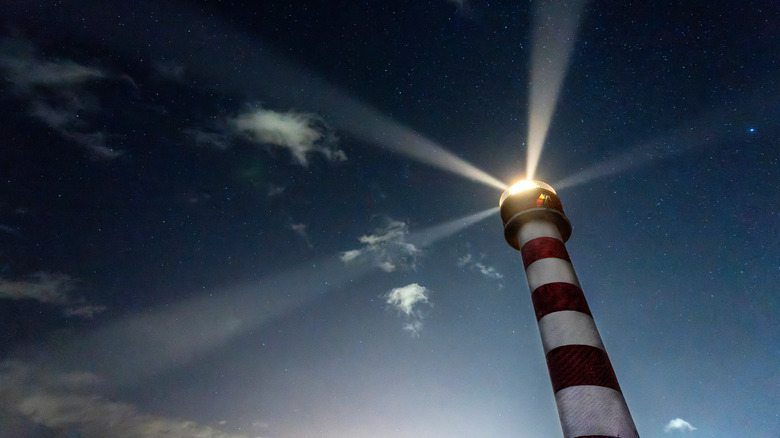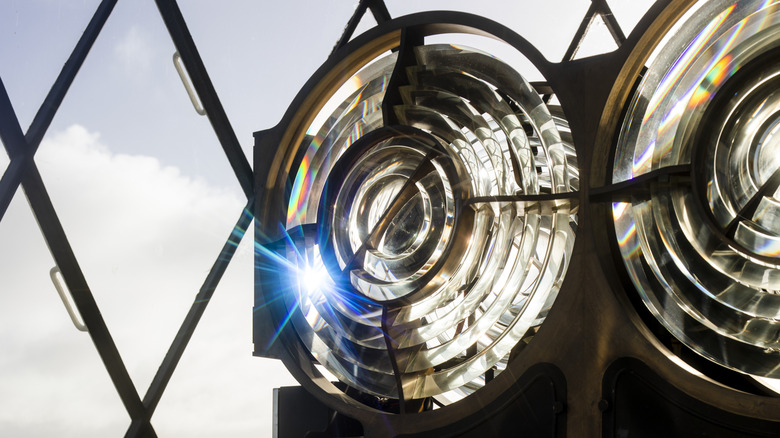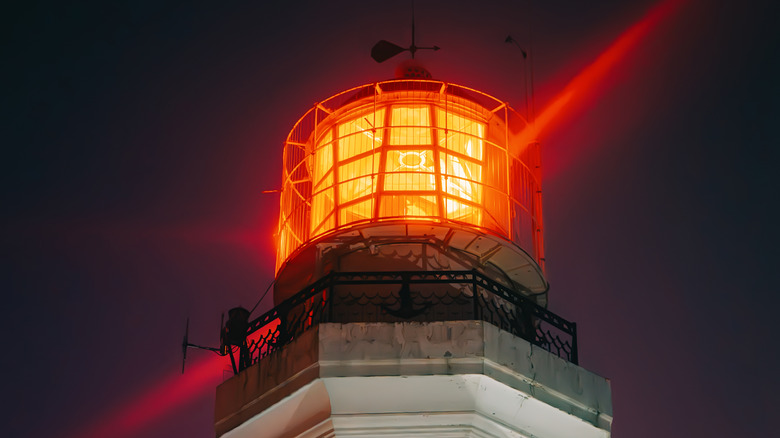Why Do The Lights In A Lighthouse Rotate? Here's How They Help Ships
Lighthouses have guided mariners safely home for centuries, with the first lighthouse reportedly constructed in ancient Egypt (although it was later destroyed). Although GPS is now in everything from smart watches to phones, ships still use lighthouses today. Although technology has a way of convincing us that older inventions no longer serve a purpose, it just takes one technological failure to quickly remind us that's not the case. In the event that a ship undergoes electronic navigation failures or weather interferes — or when a vessel is simply operating off the grid — its crew must revert to the same trusted light signals they've used to navigate before GPS was invented.
The technology in a lighthouse might be more complicated than you think. Lights in a lighthouse rotate to produce a unique flash sequence called a light characteristic, so ships can identify exactly which lighthouse they're seeing and where they are. These characteristics are standardized and published in official maritime guides like the Admiralty List of Lights and Fog Signals and the U.S. Coast Guard's light list. Mariners compare what they see at sea to these published lists, confirming their location.
The mechanics of a lighthouse light rotation
The logic behind a rotating lighthouse is similar to why emergency vehicles use flashing versus static lights. A moving or pulsing light catches the human eye faster and is much easier to recognize at a distance — especially in conditions with poor visibility. Most traditional lighthouses use a fixed light source with a giant rotating lens that focuses the light into a narrow beam that is visible from a distance of over 20 miles.
The lens design dates back to the 1820s, when French physicist Augustin Fresnel created the prism system still used in many older lighthouses today. In the 19th and early 20th centuries, the main source of light people used came from the sun or fire, typically in a kerosene or oil vapor lamp. Fresnel designed an apparatus that could refract and concentrate light, using a clockwork mechanism to rotate it. Lighthouse keepers had to manually rewind those systems every few hours to keep the light rotating.
Many of these Fresnel lenses were heavy, meaning they rotated very slowly. By the 1890s, engineers started floating the entire lens assembly on a circular trough of mercury. It worked to speed things up, but it also created a new problem: toxicity. Keepers were constantly exposed to elemental mercury, which we know can lead to poisoning. This, combined with the task of winding the heavy clockwork every few hours, eventually led the U.S. to automate its lighthouses starting in 1923. Today, all lighthouses in the U.S. are automated.
Light patterns vary depending on what kind of lighthouse it is
Some lighthouses are located on remote offshore rocks to warn ships of hidden dangers, while others are designed to guide ships safely into harbors. Because each lighthouse serves a different navigational role, its design and light patterns vary accordingly. Some lighthouses don't have the rotating light mechanism, instead using fixed LED lights that flash electronically at programmed intervals.
These lights are also designed to produce certain characteristics that ships can use to identify the lighthouse. A light might be fixed, meaning it doesn't move. It could also be flashing, with extended periods of darkness followed by short flashes of light. Finally, they could be occult lights, meaning they stay on most of the time but are briefly interrupted.
In more complex locations, lighthouses may also use sector lights, which use colors to guide ships through hazardous zones like reefs, rocks, or narrow channels. These are permanent beams that divide up the sea into risky and safe sections. If a ship sees a red sector light instead of a regular flash, it's an immediate warning that it's strayed into danger. A green sector light, on the other hand, usually marks the opposite. In both cases, these color-coded light patterns help guide ships through tight passages when a single white flash isn't enough.


